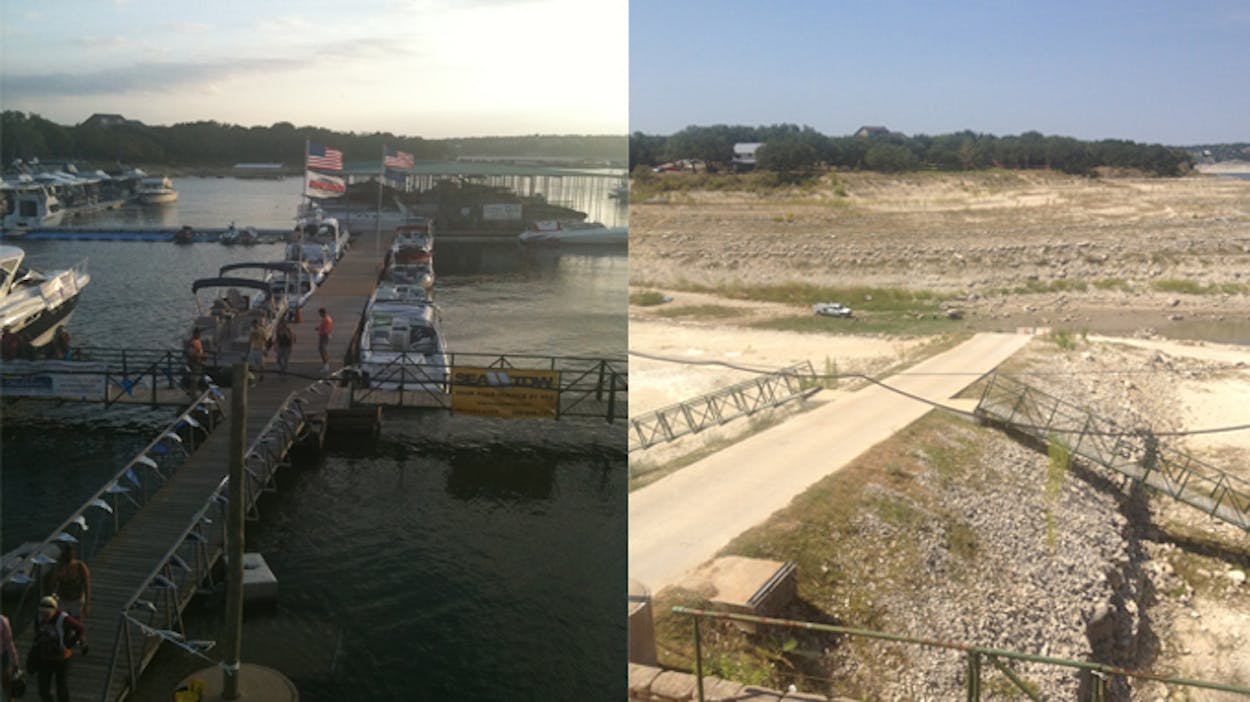A late-summer day on the lake is as much a part of Austin’s culture as live music and breakfast tacos. But that part of this area’s identity suffered a blow on Labor Day when the lingering drought forced a longtime waterfront favorite to close its doors.
Carlos’n Charlie’s, a 500-plus-seat Mexican restaurant and bar on the shores of Lake Travis that was open for nearly 20 years, shut down Sept. 2. The owners blamed a third consecutive year of dry weather.
Central Texas lakes are at their lowest levels in more than 60 years, and Lake Travis and Lake Buchanan, the reservoirs northwest of Austin that supply water to the region, now stand at just 33 percent full. These lower levels have significantly reduced customer traffic and forced many lakeside business owners to make difficult decisions.
The closing of Carlos’n Charlie’s was the latest and most visible business impact of the drought. In the past, thousands of patrons would arrive by boat and car to watch the restaurant’s annual Fourth of July fireworks show and listen to live music. But the boat docks have been unusable for more than three years.
“We hung in there for the first bad year, the second bad year, and now the third bad year,” said Pete Clark, co-owner of Carlos’n Charlie’s. “We knew that if we hung on for a fourth, we would create a hole we couldn’t dig out of.”
Mr. Clark has owned businesses in the Lake Travis area for more than 30 years, and he believes that in addition to this latest dry weather pattern, his restaurant also was caught in the state’s ongoing battle to manage its water supply.
The Lower Colorado River Authority is the state-created organization that controls the water in Lake Buchanan and Lake Travis, as well as a 600-mile stretch from San Saba to the Gulf Coast. It is the L.C.R.A.’s duty to balance the needs of both those upstream in the Austin area, where the population around the lakes has boomed, and those at end of the line in Matagorda, Wharton and Colorado counties, where rice production drives the local economies.
State water laws give the downstream users first priority and two years ago, with Texas struggling through its driest year ever, the L.C.R.A. released roughly 120 billion gallons of water to rice farmers. That summer, very little rain fell to replenish the lakes while Central Texas experienced record-breaking streaks of 100-degree temperatures. By the end of the year, Lakes Travis and Buchanan had about half as much water as they had at the beginning of the year.
The L.C.R.A. took emergency measures in 2012 and 2013 to cut off the water supply to most downstream farmers, but according to Mr. Clark, by then the damage was done.
In 2011, a coalition of governments, nonprofits and businesses commissioned a study to calculate a baseline economic and fiscal value to the area surrounding Lake Travis. The Lake Travis Economic Impact Report found that when the lake level dropped below 660 feet, visitor spending dropped by up to $33.8 million, resulting in up to 241 lost jobs and $6.1 million in lost wages a year. Lake Travis has been below 660 feet since April 2011, and the current level is about 620 feet.
A few miles away from Carlos’n Charlie’s is the Gnarly Gar, the only floating restaurant on Lake Travis. The restaurant once bobbed close to land, welcoming boaters who floated up to its docks, as well as those who walked over from the nearby village of Point Venture. But as the lake level dipped, the Gnarly Gar floated farther from shore, so that now the bridge between the marina and the land is unable to cover the distance. Todd Hynes, the restaurant’s owner, now has to bring in supplies by boat from nearby Dink Pearson Park and take garbage away first by boat, then by trailer.
“It’s really put a crimp in what we’re doing,” Mr. Hynes said. “I’m basically hanging on for two more weekends and then I’m closing the doors for the winter.”
Another local favorite, the Oasis on Lake Travis, sits on a bluff where the staff gets a daily view of the sinking lake level. The small triangle of land that is typically the first to peek through the water is called “Sometimes Island,” but now it forms the tip of what the Oasis co-manager Jody Theriot calls “Most-of-the-Time Peninsula,” a three-quarter-mile-long curving finger of land that stretches all the way back to Mansfield Dam. Mr. Theriot said his business has been down, but the Oasis has been able to persist because, unlike some of the other restaurants, most of its customers do not come from boat traffic.
With public boat ramps on Lake Travis and Lake Buchanan closed, recreational boaters have moved downstream to Lake Austin, where the L.C.R.A. has kept the level steady.
There might be some relief, however. The Texas Legislature has approved a constitutional amendment to take $2 billion from the state’s rainy-day fund to invest in water infrastructure. Voters are set to decide on the measure in November.
Between that potential long-term fix and the slim chance of near-term heavy rains, business owners like Mr. Clark hope for a recovery.
“It’s kind of like a sick friend in the hospital right now,” Mr. Clark said. “But it’s still a friend and it’s still a great place. And it will be again.”






